-
One of the great perks of my job is working with people who know a lot more than I do. On June 19th we presented the latest in the TeaSource Tea Masters workshops featuring Chaminda Jayawardana, the managing director of Lumbini Tea Factory, Deniyaya, Sri Lanka. Lumbini is one of the most awarded tea gardens/factories on Sri Lanka.
Chaminda and I had an absolute great time working together—and once again I came out of these workshops learning far more than I knew going in.

But before the workshop we had to stop and get some tea; at TeaSource in St Anthony, MN. Chaminda was traveling with his close friend, colleague, neighbor, and direct competitor Dissanayake Mudiyanselage Harris Ukkika Mahadiulwewa (henceforth referred to as “Harris”). One of the many things I love about the tea business is that competitors can be close friends; and neither the business nor the friendship has to suffer. That’s me on the left, Harris in the middle, and Chaminda on the right.
Chaminda and Harris had never tried high quality Taiwanese Jade oolongs before, so we indulged with some Tung Ting Light Roast Oolong.

Ringing Chaminda up at the St Anthony TeaSource. He saw tea paraphernalia he had never seen before, and yes, I gave him a discount.
Me, Chaminda, and Harris at St Anthony. Harris was impressed when he saw wooden tea chests from Lumbini (and other tea gardens) throughout the store.

And I got to play tour guide, taking Chaminda and Harris for a walk along the Mississippi, exploring Minnehaha Falls, visiting the Stone Arch Bridge Festival and Lake Calhoun in Minneapolis (we do have 10,000 lakes after all), and ending up at Guitar Center in Roseville, they don’t’ have Guitar Center stores in Deniyaya, Sri Lanka and Chaminda is a musician in addition to being a tea master.

Back at the TeaSource warehouse in Roseville. In preparation for the 50 people coming in for the workshop, we scavenged every chair and table throughout the building and arranged them in the open warehouse space for participants—which meant that we had nothing left in our offices/cupping room etc. Chaminda had brought 2 new samples of tea he wanted me to try. So rather than cupping them up in our cupping room (which at that point was just an empty space with no chairs or tables), we decided to sample and evaluate these teas on the customer ledge by our office administrator’s desk. We were sampling two Lumbini samples of grade OP1 grade Ceylon black tea, for some blending we will be doing later this year.

The warehouse tour for workshop participants. It always surprises me how many people want a tour of our work space.
Chaminda and I start talking about tea. Chaminda’s role was to be the expert and to make sure everyone (including me) walked out knowing a lot more about growing Ceylon tea, than we knew coming in. My role was mostly comic relief and amazement at the tea-maker’s craft. We had a lot of fun together.
Lumbini Estate (and all Ceylon tea gardens) had only dealt with tea brokers until I convinced Chaminda to bypass brokers and sell directly to wholesale customers. Chaminda and Lumbini now sell direct to more than 15 countries across the world. TeaSource was first.

This Lumbini Silver Needles is the first tea I bought from Chaminda. I brought back 2 gigantic duffle bags stuffed with this tea when I flew back from my first visit to Lumbini. To me the most amazing part of this tea is the fact that Chaminda had never heard of Chinese Yin Zhen (Chinese Silver Needle white tea), when he created his own Silver Needles.
The TeaSource infographic on Ceylon and Ceylon teas. It shows all the major growing regions, and Lumbini Tea Factory.
I took a couple of minutes to read from my great grandfather’s memoir. He was in Ceylon in the 1860’s and 1870’s helping establish the first tea gardens.
“I will mention here a few things a young tea planter should learn as soon as possible. First and foremost he must learn to speak to the coolies in their own language - the Tamil. He must learn how to make nurseries from seed or cutting, how to prune and care for the crops, drain and make roads in the new plantation. He must also learn to design and superintend the building, whether in wattle and dab for the coolies’ “huts” or in brick and stone for his own building. He must learn something of sickness and the simple medicines to give. He should, by all means, know enough to sew a button, in an extremity ….
I wish here to remark on my affection for the kindness, and “bon comradie” (sic) of all the tea planters I met in Ceylon. We used to meet at each other’s bungalows and have a “sing a song.” Each one had to sing a song and tell a story, or drink a glass of salt and water. I shall never forget those days.”
From “The Life and Travels of Augustus Waddington”
an unpublished memoir, 1870
Augustus Waddington, Welsh tea man in CeylonChaminda examining the leaf, and explaining the detail of why Lumbini teas are so special and have won so many awards. They are all hand-plucked and orthodox processed, i.e. minimal use of machines during processing. It is so much fun to listen to someone who is expert and passionate about their field.
Everyone sampled six Ceylon different teas (and went home with a couple of more). One of the amazing things about Ceylon teas is that while it is a small island: the diversity of tea styles, flavors, is huge.
- Lumbini Silver Needles | White Tea
- Oodooware Estate, Pekoe | Black Tea
- Gonapitiya Estate, FBOP | Black Tea
- Ceylon Blend Mid-Grown | Black Tea Blend
- Ceylon Burning Sun | Black Tea Blend
- Inverness Estate, FBOPF1 | Black Tea
“Stick your nose in the cup.” During workshops I say that a lot. Tea is as much an olfactory experience as it is a taste experience.

The community of Twin Cities tea enthusiasts has grown quite large and is …. well …. enthusiastic. And it is a whole lot of fun when we all get together and sample and talk teas.
And of course, since this was a celebration (of Ceylon teas) everyone had to walk home with some swag bags.

Me, autographing a Ceylon tea poster—that was a little unusual, but wisely the participant had asked for Chaminda’s autograph first.

Chaminda and one of the many appreciative attendees. People did seem to have a great time.
Good tea makes good friends. Lumbini is some of the best tea, so it’s not surprising it has led to one of the best friendships.
Bill Waddington
-
TeaSource will be educating, sampling, promoting, and introducing new varieties of the most famous of all Japanese green teas, Matcha, this summer and into the fall. We’ll also be putting up a series of blog posts about Matcha, so if you haven’t done so already, follow us on Twitter and Facebook.
Let's get started!

Boiling it Down: What is Matcha?
Matcha is a powdered green tea from Japan. It is made from a high grade tea that is shaded for at least three weeks before plucking. Shading causes the leaves to produce much more chlorophyll, giving the tea a brilliant emerald color. The leaves are then ground into a fine powder. Traditionally, matcha is used in the Japanese tea ceremony. The first formal tea ceremony in Japan occurred in the eighth century when the emperor invited monks to take tea at his palace. Tea was a rare and valuable commodity at the time and it was used primarily in religious settings or for medicinal purposes. Today, matcha is not bound by the same social and economic formalities. It can be enjoyed hot or cold, in ice cream, smoothies, and lattes.
-

The World Tea Expo (or WTE) is the world’s largest international tea exhibition (there are larger tea expos in China that are strictly Chinese not international), was held in Las Vegas this year.
With exhibitors and speakers from the Twin Cities, San Francisco, NYC, Hamburg, London, Argentina, Bolivia, South Africa, Malawi, Kenya, India, Nepal, Sri Lanka, Taiwan, China, Japan, Indonesia, the TeaSource crew gets to hang out with other tea geeks.

TeaSource was very happy to be there, and as usual we had lots going on at our booth. Including a special presentation by Taiwan’s Ambassador of Tea, Thomas Shu, who did an extensive workshop on Taiwanese oolongs. Above are the four teas Thomas shared with the crowd: Jade Oolong, Amber Oolong, Oriental Beauty and Ruby 18.

Thomas Shu (above) did the hard part; educating and entertaining about tea. If you’ve never heard Thomas Shu sing check this out.
We had the easy part; just preparing and distributing the tea. One comment from an experienced Sri Lankan tea grower, about the Jade Oolong, “This might be one of the best teas I’ve ever tasted.”

The Lumbini Tea Booth was one of the most happening places at the World Tea Expo (Chaminda is at the far left). There was always a crowd there for two reasons: the tea is great and the Lumbini guys love talking about tea.
Nigel Melican, me, and Raj from Stone Mountain tea. That is not a skeptical look on my face, it is more a “I’m not worthy, I’m not worthy” look. Nigel is the western world’s most respected tea scientist. If you like the geeky side of tea and/or took apart household appliances as a kid—you will really appreciate Nigel… check out this interview.
In the photo above he is estimating the catechin level of one of Raj’s tea, by simply tasting it, and the amazing thing is he would end up being pretty accurate.
The WTE is THE major trade show for the specialty tea industry; and TeaSource is proud to be part of this community of tea traders, tea teachers (and students), and tea geeks. TeaSource presented four different workshops/classes, did tons of sampling at our booth, and met some wonderful new tea people. It was a great week drinking and talking tea.
Bill Waddington
TeaSource, Owner -
It's the perfect time of year to host an afternoon tea party. Whether it's for Mother's Day or just a gathering of good friends, cook up these delicious recipes, steep up some TeaSource tea, and have a great time!
Even more recipes can be found here. Enjoy!

Goat Cheese and Asparagus Pinwheels
Makes 2 dozen4 tortillas
½ cup goat cheese
½ pound asparagus
Olive oil
Salt and pepperPreheat oven to 350 degrees. Place the asparagus on a baking sheet and drizzle with olive oil, salt and pepper. Bake for 12-15 minutes until asparagus is tender. Let cool.
Spread each tortilla with a thick layer of goat cheese. Sprinkle with salt and pepper.
Place 6 spears of asparagus in each tortilla and roll up.
Slice each into 6 slices and serve immediately.
 Turkey, Pesto and Arugula Finger Sandwiches
Turkey, Pesto and Arugula Finger Sandwiches
Makes 1 dozen6 slices bread
¼ pound smoked turkey
¼ cup prepared pesto
1 cup arugulaSpread a thin layer of pesto on each slice of bread.
Layer turkey and arugula on three slices and top with remaining three slices of bread.
Cut the crusts off each sandwich and cut into four finger sandwiches.
Ham and Cheese Scones
Makes 1 dozen1 egg
½ cup plain Greek yogurt
2 cups flour
1 teaspoon baking powder
¼ teaspoon baking soda
½ teaspoon salt
1 stick (8 tablespoons) butter, frozen
¼ pound Virginia Ham, cut into cubes
¼ pound colby jack cheese (or cheddar, swiss, pepper jack, what have you), cut into cubes
¼ chives, chopped
¼ cup milk (plus extra for brushing)
Black pepperPreheat oven to 400 degrees.
In a small bowl, mix the egg and yogurt to combine. Set aside.
In a large bowl, combine flour, baking powder, baking soda and salt. Grate the butter into the flour mixture using a large grater (can also be cut into pea-sized cubes). Mix the butter into the dry ingredients. It should look like a coarse meal.
Add the egg mixture to the flour and butter mix and stir to combine. Add the ham, cheese and chives. Stir to combine. Mix in the milk. The batter will be extremely thick, and pretty lumpy-this is how it’s supposed to look.
Drop scones by ¼ cup full onto a baking sheet. Brush the tops with milk and crack some fresh pepper over the top.
Bake 15-20 minutes until golden brown and the cheese starts to melt. Let cool on the pan until ready to serve.

Roasted Shrimp Salad in Endive
Makes 2 dozen1 pound shrimp, deveined (raw and still in the shell!)
3 heads endive
¼ cup red onion, minced
¼ cup red bell pepper, minced
½ cup mayonnaise
1 tablespoon Dijon mustard
2 tablespoons fresh parsley, chopped
1 tablespoon lemon juice
Olive oil
Salt and pepperPreheat oven to 400 degrees. Place shrimp on a baking sheet, drizzle with olive oil, salt and pepper. Roast for 15 minutes until shrimp turns pink and just starts to curl. (C=cooked, O=overcooked)
Let shrimp cool. Peel and chop into bite sized pieces.
Combine shrimp, onions, peppers, may, mustard, parsley and lemon juice. Stir well to combine. Season with salt and pepper as needed. Chill for 4 hours.
Cut the root end off of the endive and separate the leaves. Wash and dry well.
Fill each endive leaf with shrimp salad and serve immediately.

PB&J Petit Fours
Make 3 dozen1 ½ cups powdered sugar
4 tablespoons creamy peanut butter
1 teaspoon vanilla
4 tablespoons milk
6 slices white bread
1/3 cup strawberry jam
Peanuts for garnishIn a small bowl combine powdered sugar, peanut butter, vanilla and milk. Stir well to combine. There is no need to heat the peanut butter, it will combine with the other ingredients on its own.
Spread the jam on three slices of bread. Top with the remaining slices.
Cut of the crusts and cut each sandwich into twelve squares.
Place the squares on a rack over a baking sheet and pour the glaze over the squares to cover. Place a peanut on each for garnish.
Chill at least one hour before serving.
Spiced Chocolate Petit Fours
Makes 4 dozen (or one 9x13 cake)1 ¾ cups all purpose flour
2 cups sugar
¾ cup cocoa powder
1 ½ teaspoons baking soda
1 ½ teaspoons baking powder
1 teaspoon salt
1 ½ teaspoons cinnamon
1 teaspoon cayenne pepper
2 eggs
1 cup milk
½ cup vegetable oil
2 teaspoons vanilla
1 cup boiling water
Spiced Chocolate glaze (see below)Preheat oven to 350 degrees.
In a large mixing bowl, combine all of the dry ingredients and whisk well to combine.
Stir in the eggs, milk, oil and vanilla. Whisk for two minutes until all ingredients are well incorporated.
Using a spoon, slowly stir in the boiling water. DO NOT OVERMIX, batter should appear very thin.
Pour into an ungreased 9x13 baking dish and bake for 30-40 minutes until a toothpick inserted in the center comes out clean.
If you wanted to make a cake, let cool completely before adding glaze or frosting of your choice.
If you want to make petit fours, let the cake cool completely and freeze for 1-2 hours to make it easier to cut into 1x1 squares. Place squares on a cooling rack and pour glaze over each, covering completely. Chill until ready to serve.
Spiced Chocolate Glaze
8 ounces semisweet chocolate
6 tablespoons heavy cream
6 tablespoons light corn syrup
1 teaspoon cinnamon
¼ teaspoon cayenne pepperBring cream and corn syrup to a boil over medium heat. Add the chocolate, cinnamon and cayenne. Let rest 5 minutes until chocolate is melted and whisk to combine.
-
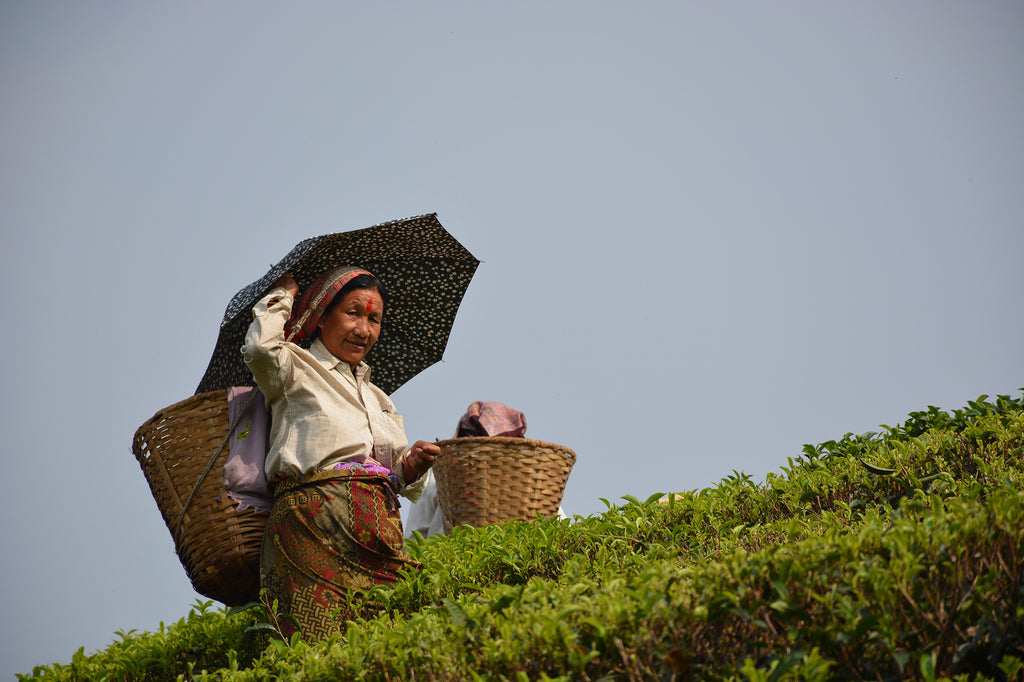
When I travel to tea country I am searching for teas; but the most memorable thing is always the people. Sometimes it’s the beginning of lifelong friendships, sometimes it’s a just a chance encounter on a dusty road. But I remember the people and keep them in my heart, long after I’ve sold out of the teas.
Since March is Darjeeling month I wanted to show some of the wonderful people of Darjeeling I encountered on my last trip to India.

In the offices of Darjeeling tea master and exporter, Rajiv Gupta, receiving a book on Darjeeling he helped produce.

Sudhanshu Kumar Shaw and his manager by the rolling machine at Giddapahar Estate. This is one of our favorite Darjeeling tea gardens.

At Goomtee Tea Estate, they also have a small greenhouse. Here is the assistant manager of the Goomtee factory making sure I have some fresh flowers when it is time to hit the road.
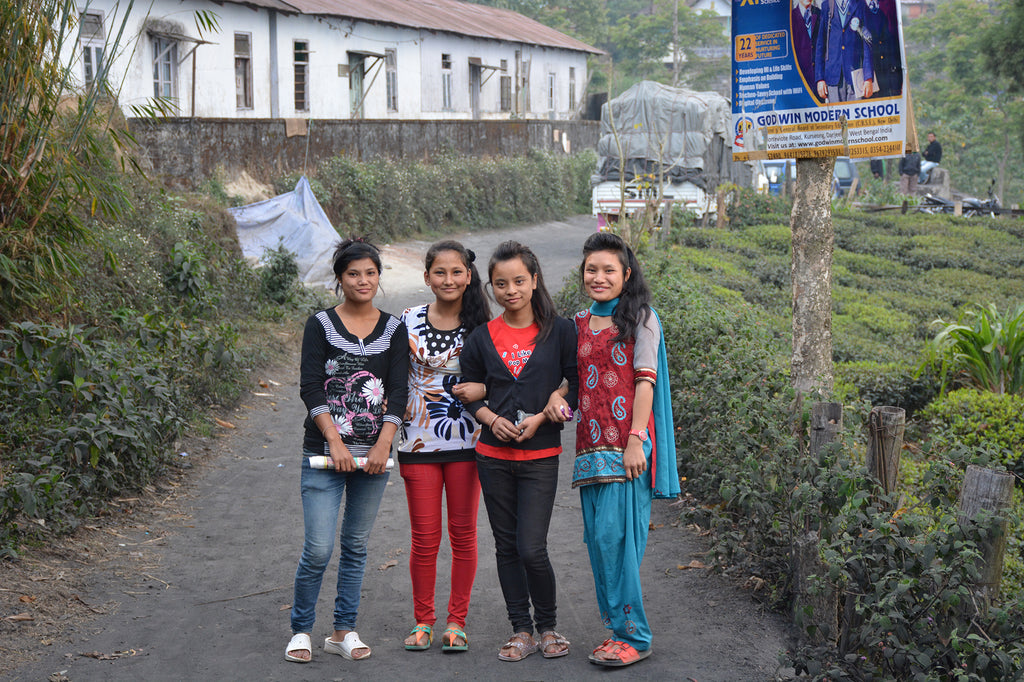
I took a long walk near the Goomtee Estate, these four teenage girls asked me to take their picture.
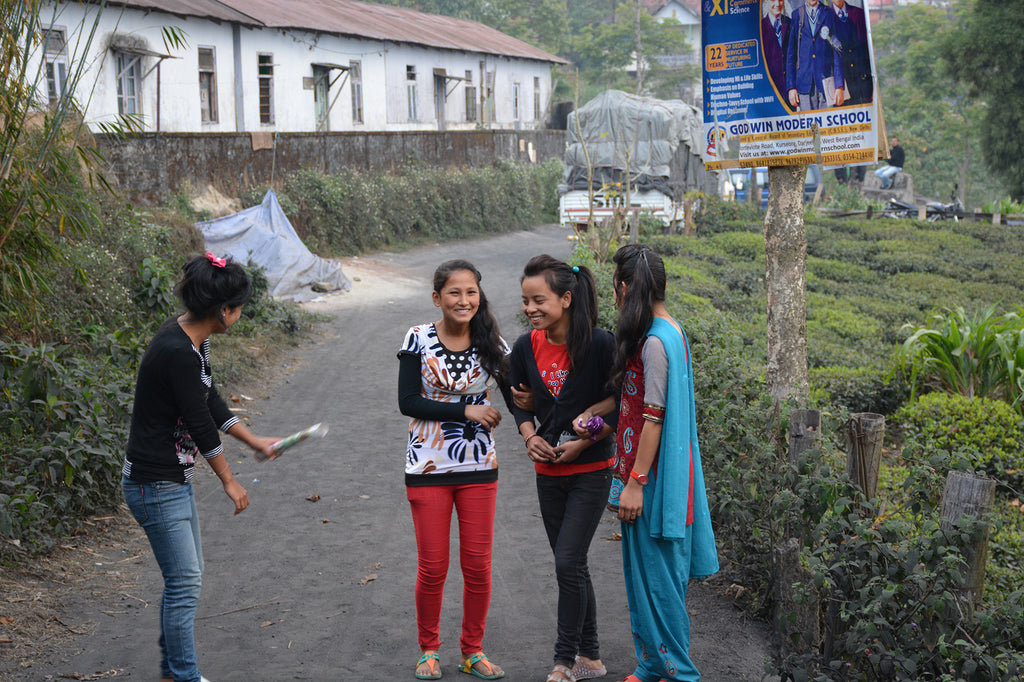
Immediately after which, they cracked themselves up.

Tea pluckers at the Rohini Estate. One of the few spots where the Darjeeling tea fields are not scaling up a mountainside.

Enjoying tea at a road-side café in the mountains of Darjeeling.

Watching Indian milk tea being made at a stall in Darjeeling near the Nepalese border.
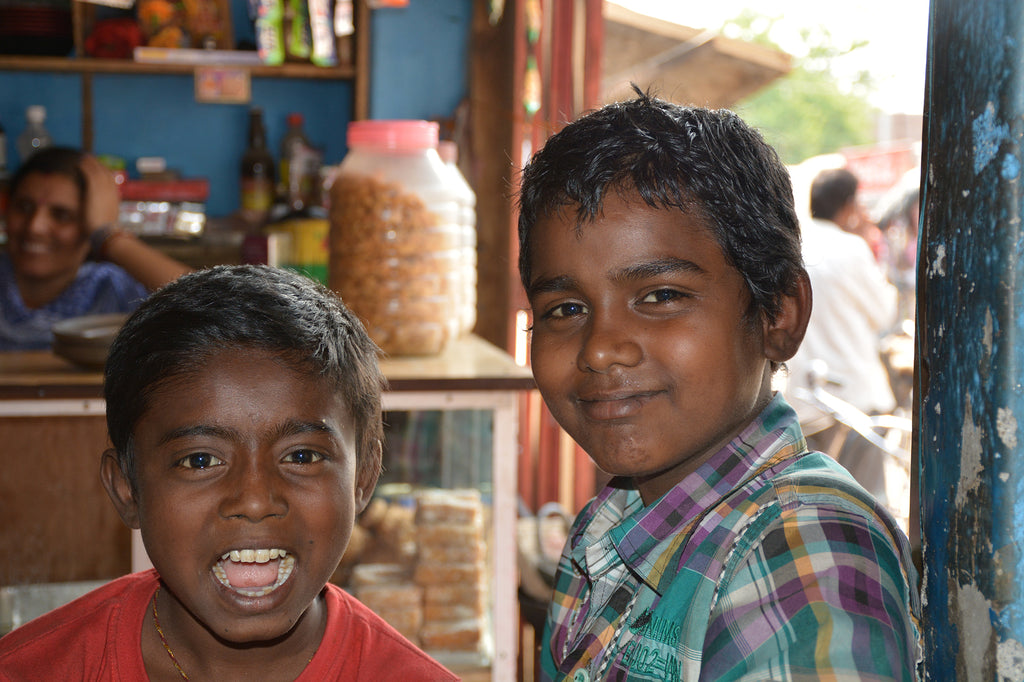
Kids hanging out, while Mom (see above) makes milk tea, and dad laughs in the background.

Cupping teas at the Castleton Estate with one of the assistant managers of the factory making the tea. You can tell they are first flush teas by light golden/yellow color.

Having way too much fun tasting teas, with the manager of the Belgachi Estate, on the outskirts of the Darjeeling district. As we were standing for our formal photo, he suddenly leaped and shoved that bag of tea into my hands.

Siliguri (the largest town in Darjeeling District); two ladies out and about.

A vendor greeting his customer in the Siliguri market area.

A chai wallah selling her chai on the streets of Siliguri.

Kids, on their way home from school near Kuresong, Darjeeling.

Lots of school kids hitching a ride home at the end of the day.
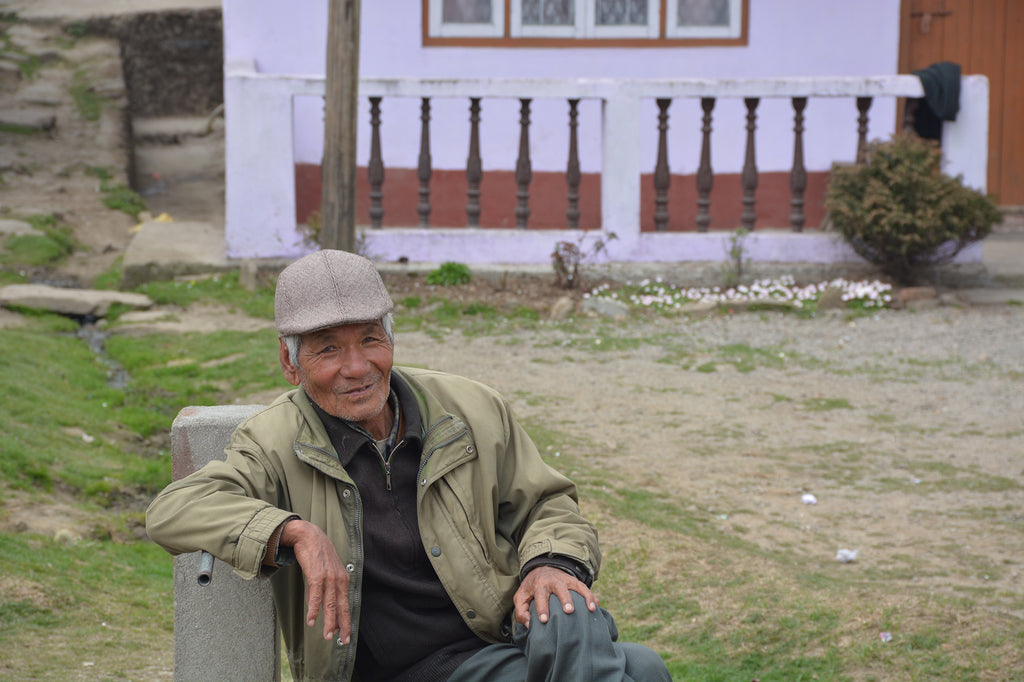
A retired veteran of the India Gurkha Rifles, living the good life on the Nepal/Darjeeling border. One of the most interesting men I’ve ever met.

Walking down the road in this same Darjeeling/Nepal village, Dilma graciously invited me into her home for tea; milk tea it turns out—she had to run out and milk the cow and get some fresh milk.
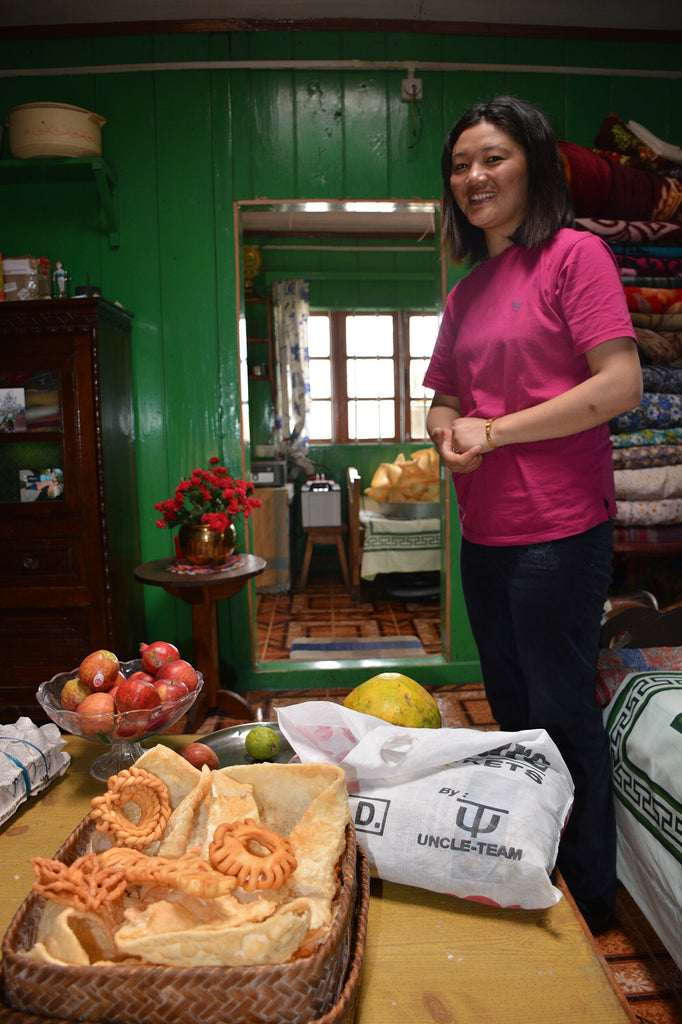
Dilma, in the living room of her lovely home; with home-made fried sweet bread to go with the tea. She was incredibly gracious and hospitable to a couple of strangers walking down the road.

Rajah Banerjee, the first organic planter in Darjeeling, and the patriarch of Makaibari Tea Estate.
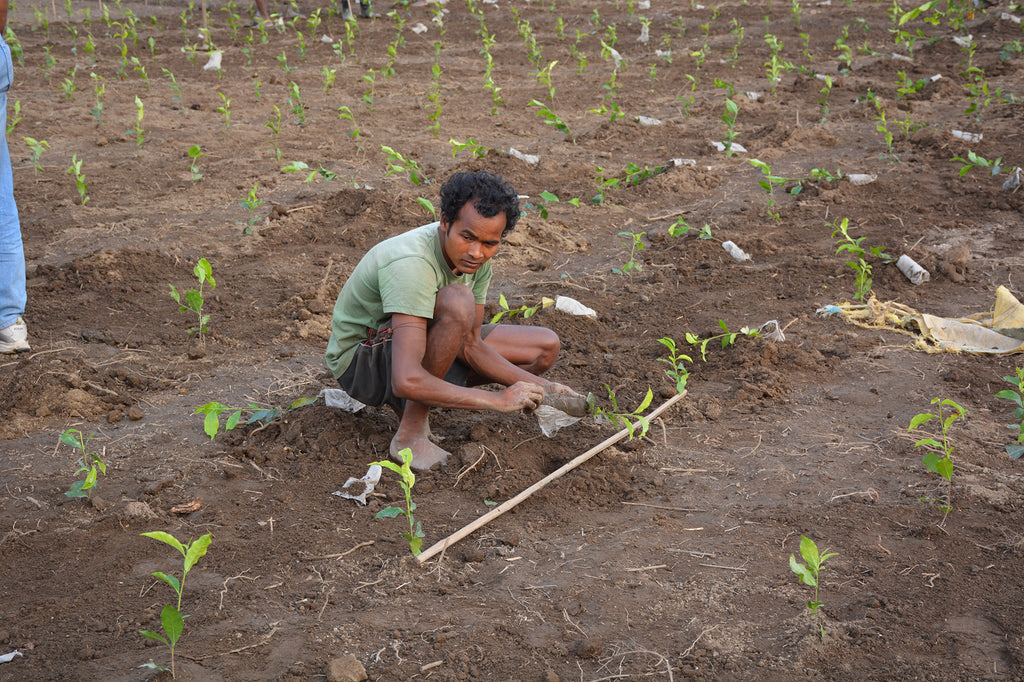
Planting some new tea plants at Margaret’s Hope Estate.

These guys were playing soccer on the dirt road separating two fields of tea plants in lower Darjeeling. Most of them had family working on the tea estates.
Wherever you go, whatever you do, it’s the people that matter the most.
(although a good cup of Darjeeling can be amazing).-Bill Waddington
All photos property of TeaSource, and may not be used for commercial purposes without express permission.
Copyright TeaSource © 2015 -
Giddapahar was founded in 1881, and has been in the same family ever since. Surendra Nath Singh and his brother are the fourth generation to be running the estate. And since this garden was brought to my attention about six years ago, they have consistently produced some of the best (and most reasonably priced) Darjeeling teas I have seen.
Take a brief peek at the Giddapahar Tea Estate....

The entrance to Giddapahar Tea Estate, the smallest Darjeeling tea garden. The entire estate, factory, and owner’s home are built on slopes like this.

While small in size, Giddapahar looms large to tea merchants looking for the best quality. Pictured above are a couple of tea merchants from Siliguri, India and Taipei, Taiwan. The three of us met there, while looking for some special teas. In the background is the owner’s home, just a few short steps from the Giddapahar factory.

Having tea in the owner’s office at Giddapahar. Notice the pale yellow color of this delicate 1st flush Darjeeling, which was made that morning.

On the left, one of the owners of Giddapahar, Sudhanshu Kumar, and his factory manager behind the desk; enjoying a break and talking tea. Sudhanshu and his brother Himanshu own and run Giddapahar; it’s been in their family since the 1880’s.

A tea rolling machine at Giddpahar. This machine is close to 100 years old and made in Birmingham, England, it still helps make great tea today.

The heating chamber (and the factory manaager, who is also the only full-time employee of Giddapahar), which is used for “firing” the tea, the last step of traidtional tea manufacture.

Immersing myself in the incredible aromas of just made Darjeeling tea.

Himanshu Kumar, closely monitoring the tea during the manufacturing process. Behind him is a tea sorting machine (that shakes and sorts the different sized particles of tea). The folks at Giddapahar made this tea sorting machine themselves.

Close up of the tea sorting machine. You can see the chutes/funnels that siphon off the different sized particles.

The porch and the vista outside of the owner’s office. The Darjeeling mountainside is so steep here, that the slope drops off at about an 80 degree angle, but the entire slope is still filled with tea bushes that are hand-plucked by local workers.
-Bill Waddington
TeaSource Owner


























 Turkey, Pesto and Arugula Finger Sandwiches
Turkey, Pesto and Arugula Finger Sandwiches

































